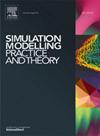Numerical simulation of hydraulic fracture extension patterns at interfaces of coal-measure rock strata and a new theoretical prediction model
IF 3.5
2区 计算机科学
Q2 COMPUTER SCIENCE, INTERDISCIPLINARY APPLICATIONS
引用次数: 0
Abstract
Coal-measure gas (CMG), a unique form of unconventional natural gas located within coal seams and surrounding rock layers, represents a potential avenue for enhancing energy consumption patterns while mitigating carbon emissions. The geological structure of CMG reservoirs exhibits pronounced variability in layer strength and contains vertical discontinuities at lithological boundaries. These boundaries, shaped by sedimentation and tectonic forces, possess varying adherence strengths and inclinations, influencing the behavior of hydraulic fracturing fluids. Upon reaching such interfaces, fracturing fluids might either halt or propagate along them, thereby affecting the vertical expansion of hydraulic fractures. In this study, nine modes of hydraulic fracture extension at the interface of coal-measure rock strata were obtained by simulation using ABAQUS embedded in a 0-thickness Cohesive element.This study highlights how the disparity between the interface bond strength and adjacent rock mass primarily dictates fracture propagation direction under low vertical stress difference coefficient (k). A minimal disparity facilitates vertical fracture continuation through the interface. Conversely, with increasing k values, the influence of interface strength on fracture direction diminishes. Additionally, lower interface dip angles β correlate with heightened vertical stresses, promoting fracture vertical propagation. Furthermore, it fully considers the combined effect of tension and shear in the process of hydraulic fracture extension, and establishes a prediction model for the extension trajectory of hydraulic fracture at the interface of coal-measure rock strata based on the theory of maximum energy release rate and the mixed fracture energy criterion. This research offers novel insights into the mechanisms governing hydraulic fracture expansion at coal-measure rock strata interfaces and the critical factors influencing cross-interface propagation.
求助全文
约1分钟内获得全文
求助全文
来源期刊

Simulation Modelling Practice and Theory
工程技术-计算机:跨学科应用
CiteScore
9.80
自引率
4.80%
发文量
142
审稿时长
21 days
期刊介绍:
The journal Simulation Modelling Practice and Theory provides a forum for original, high-quality papers dealing with any aspect of systems simulation and modelling.
The journal aims at being a reference and a powerful tool to all those professionally active and/or interested in the methods and applications of simulation. Submitted papers will be peer reviewed and must significantly contribute to modelling and simulation in general or use modelling and simulation in application areas.
Paper submission is solicited on:
• theoretical aspects of modelling and simulation including formal modelling, model-checking, random number generators, sensitivity analysis, variance reduction techniques, experimental design, meta-modelling, methods and algorithms for validation and verification, selection and comparison procedures etc.;
• methodology and application of modelling and simulation in any area, including computer systems, networks, real-time and embedded systems, mobile and intelligent agents, manufacturing and transportation systems, management, engineering, biomedical engineering, economics, ecology and environment, education, transaction handling, etc.;
• simulation languages and environments including those, specific to distributed computing, grid computing, high performance computers or computer networks, etc.;
• distributed and real-time simulation, simulation interoperability;
• tools for high performance computing simulation, including dedicated architectures and parallel computing.
 求助内容:
求助内容: 应助结果提醒方式:
应助结果提醒方式:


